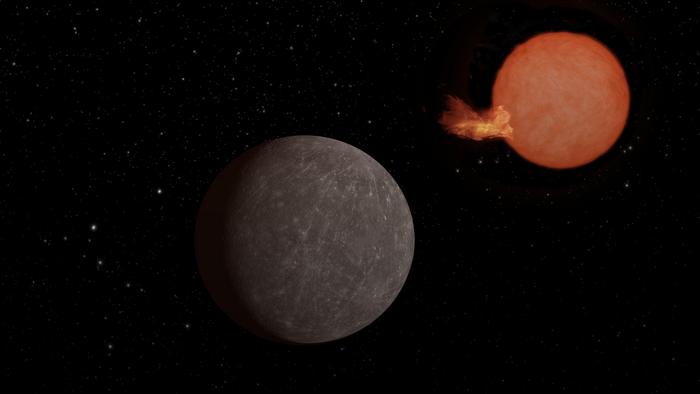The SPECULOOS project, led by the astronomer Michaël Gillon from the University of Liège, has just discovered a new Earth-sized exoplanet around SPECULOOS-3, an “ultracool dwarf” star as small as Jupiter, twice as cold as our Sun, and located 55 light-years from Earth. After the famous TRAPPIST-1, SPECULOOS 3 is the second planetary system discovered around this type of star.

Credit: NASA/JPL-Caltech
The SPECULOOS project, led by the astronomer Michaël Gillon from the University of Liège, has just discovered a new Earth-sized exoplanet around SPECULOOS-3, an “ultracool dwarf” star as small as Jupiter, twice as cold as our Sun, and located 55 light-years from Earth. After the famous TRAPPIST-1, SPECULOOS 3 is the second planetary system discovered around this type of star.
Ultra-cool dwarf stars are the least massive stars in our Universe, similar in size to Jupiter, more than twice as cold, ten times less massive and a hundred times less luminous than our Sun. Their lifespan is over a hundred times longer than that of our star, and they will be the last stars to shine when the Universe becomes cold and dark. Although they are far more common in the Cosmos than Sun-like stars, ultra-cool dwarf stars are still poorly understood due to their low luminosity. In particular, very little is known about their planets, even though they represent a significant fraction of the planetary population of our Milky Way.
It’s against this backdrop that the SPECULOOS consortium, led by the University of Liège, has just announced the discovery of a new Earth-sized planet orbiting a nearby ultra-cool dwarf star. The SPECULOOS-3 b exoplanet lies around 55 light-years from Earth (which is very close on a cosmic scale! Our galaxy, the Milky Way, stretches over 100,000 light-years). SPECULOOS 3 is only the second planetary system to be discovered around this type of star: “SPECULOOS-3 b is practically the same size as our planet,” explains the astronomer Michaël Gillon, first author of the article published in Nature Astronomy. A year, i.e. an orbit around the star, lasts around 17 hours. Days and nights, on the other hand, should never end. We believe that the planet rotates synchronously, so that the same side, called the day side, always faces the star, just like the Moon does for the Earth. On the other hand, the night side hand, would be locked in endless darkness.”
The SPECULOOS (Search for Planets EClipsing ULtra-cOOl Stars) project, initiated and led by astronomer Michaël Gillon, has been specially designed to search for exoplanets around the nearest ultra-cold dwarf stars. These stars are scattered across the sky, so you must observe them one by one, over a period of weeks, to have a good chance of detecting transiting planets,” continues the researcher. This requires a dedicated network of professional robotic telescopes.” This is the concept behind SPECULOOS, jointly run by the Universities of Liège, Cambridge, Birmingham, Berne, MIT and ETH Zürich.
“We designed SPECULOOS specifically to observe nearby ultra-cool dwarf stars in search of rocky planets that lend themselves well to detailed studies,” comments Laetitia Delrez, astronomer at the University of Liège. In 2017, our SPECULOOS prototype using the TRAPPIST telescope discovered the famous TRAPPIST-1 system made up of seven Earth-sized planets, including several potentially habitable ones. This was an excellent start!“
The SPECULOOS-3 star is more than twice as cold as our sun, with an average temperature of around 2,600°C. Due to its hyper-short orbit, the planet receives almost sixteen times more energy per second than the Earth does from the Sun and is therefore literally bombarded with high-energy radiation. “In such an environment, the presence of an atmosphere around the planet is highly unlikely,” says Julien de Wit, MIT professor and co-director of the SPECULOOS Northern Observatory and its Artemis telescope, co-developed by the University of Liège and MIT, and the mainstay of this discovery. The fact that this planet has no atmosphere could be a plus in several respects. For example, it could enable us to learn a great deal about ultra-cool dwarf stars, which in turn will make possible more in-depth studies of their potentially habitable planets.”
SPECULOOS-3 b is proving to be an excellent target for the JWST space telescope, to be launched in 2021, whose data will revolutionize our vision of the Universe. “With the JWST, we could even study the mineralogy of the planet’s surface!” enthuses Elsa Ducrot, a former researcher at the University of Liège now based at Paris Observatory.
“This discovery demonstrates the ability of our SPECULOOS-North observatory to detect Earth-sized exoplanets suitable for detailed study. And this is just the beginning! Thanks to the financial support of the Walloon Region and the University of Liège, two new telescopes, Orion and Apollo, will soon join Artemis on the plateau of the Teide volcano in Tenerife, to speed up the hunt for these fascinating planets” concludes Michaël Gillon.
Journal
Nature Astronomy
Article Title
Detection of an Earth-sized exoplanet orbiting the nearby ultracool dwarf star SPECULOOS-3
Article Publication Date
15-May-2024



